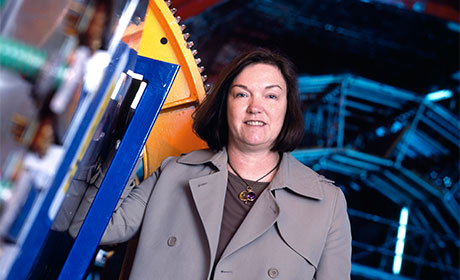New Findings on the Formation of Matter
20 September 2018
Nuclear physics experiments open up a view into the beginnings of the universe
Scientific consensus currently holds that the building blocks of matter in our everyday world were formed in the first 10 microseconds of its existence. After the Big Bang about 13.7 billion years ago, matter consisted mainly of quarks and gluons, two types of elementary particles. In the early universe, these particles moved freely in a quark-gluon plasma. Then, in a phase transition, they combined and formed hadrons, among them the building blocks of atomic nuclei – protons and neutrons. An international team of scientists now presents an analysis of a series of experiments at major particle accelerators that sheds light on the nature of this transition. Some of the experiments were performed at the highest energies worldwide using the ALICE detector at the Large Hadron Collider of the CERN European Organization for Nuclear Research. The researchers determined with precision the transition temperature and obtained new insights into the mechanism of cooling and “freeze-out” of the quark-gluon plasma into the current constituents of matter. The team of scientists includes researchers from the GSI Helmholtzzentrum für Schwerionenforschung in Darmstadt, and from the universities of Heidelberg, Münster and Wroclaw (Poland). They published their results in “Nature”.
Nuclear and Particle Physics at Heidelberg University

Photo: A. Saba / CERN
The Heidelberg research group at the Institute for Physics of Heidelberg University under the direction of Prof. Dr Johanna Stachel has been a member of ALICE since 1996 and played a major role in the design, construction and operation of the experiment as well as in analysing the data. Prof. Stachel is leader of the one of the main detector components of ALICE, the TRD (transition radiation detector) project, and was deputy leader of the TPC (time projection chamber) project. She and her group are vital contributors to the successful ALICE experiment. In Germany, the funding for the LHC experiments is structured into four research focuses (FSPs) of the Federal Ministry of Education and Research. From the start of the FSPs, Prof. Stachel has served as spokesperson for FSP202-ALICE. The phenomenological studies to interpret the ALICE data that are the focus of the current “Nature” publication were conducted under the auspices of the “Isolated quantum systems and universality under extreme conditions” Collaborative Research Centre (CRC1225/ISOQUANT) at Ruperto Carola. Prof. Stachel is deputy spokesperson of CRC 1225, which is funded by the German Research Foundation (DFG).

